sensor LEXUS LS430 2003 Factory Repair Manual
[x] Cancel search | Manufacturer: LEXUS, Model Year: 2003, Model line: LS430, Model: LEXUS LS430 2003Pages: 4500, PDF Size: 87.45 MB
Page 2424 of 4500
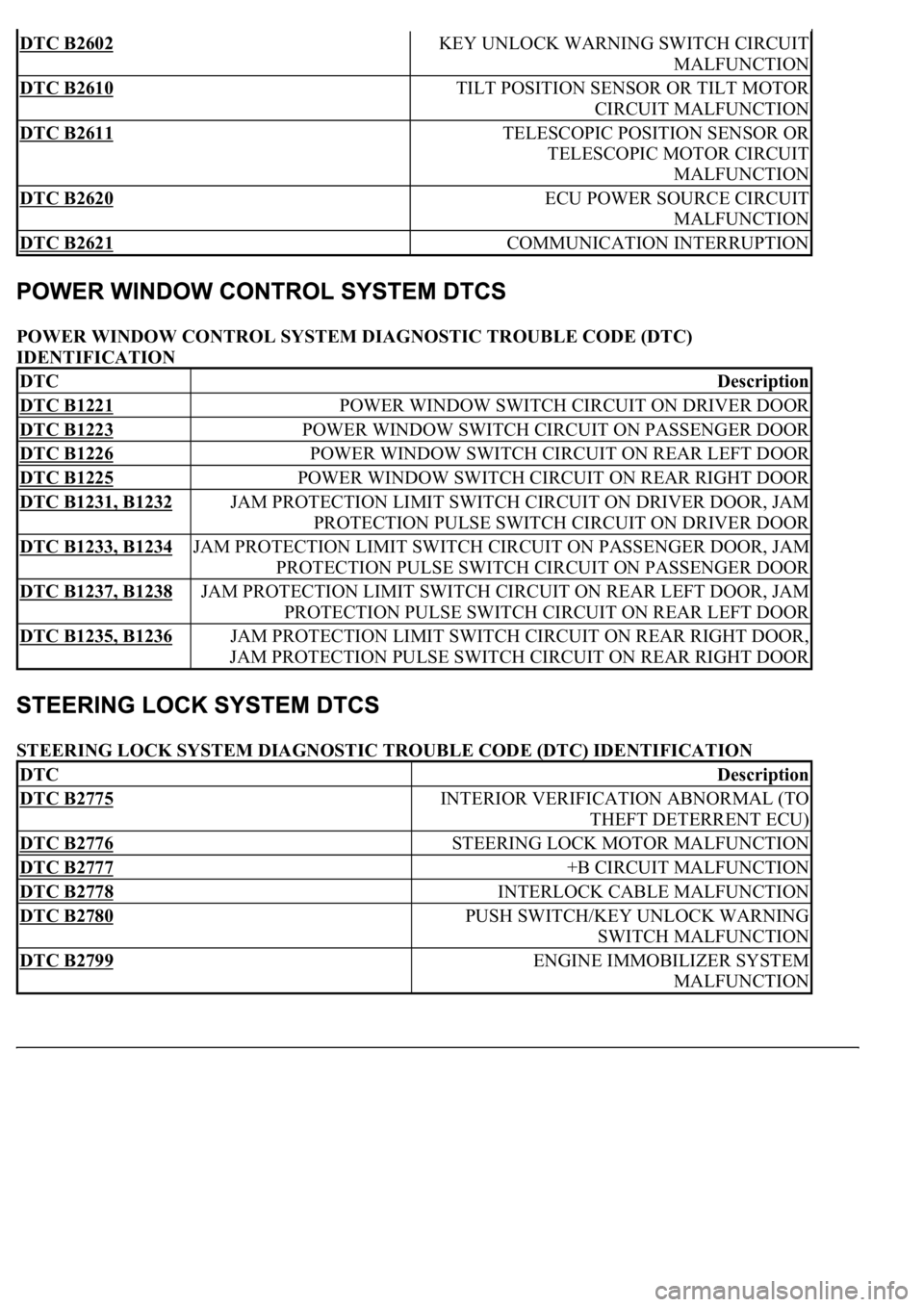
POWER WINDOW CONTROL SYSTEM DIAGNOSTIC TROUBLE CODE (DTC)
IDENTIFICATION
STEERING LOCK SYSTEM DIAGNOSTIC TROUBLE CODE (DTC) IDENTIFICATION
DTC B2602 KEY UNLOCK WARNING SWITCH CIRCUIT
MALFUNCTION
DTC B2610 TILT POSITION SENSOR OR TILT MOTOR
CIRCUIT MALFUNCTION
DTC B2611 TELESCOPIC POSITION SENSOR OR
TELESCOPIC MOTOR CIRCUIT
MALFUNCTION
DTC B2620 ECU POWER SOURCE CIRCUIT
MALFUNCTION
DTC B2621 COMMUNICATION INTERRUPTION
DTCDescription
DTC B1221 POWER WINDOW SWITCH CIRCUIT ON DRIVER DOOR
DTC B1223 POWER WINDOW SWITCH CIRCUIT ON PASSENGER DOOR
DTC B1226 POWER WINDOW SWITCH CIRCUIT ON REAR LEFT DOOR
DTC B1225 POWER WINDOW SWITCH CIRCUIT ON REAR RIGHT DOOR
DTC B1231, B1232 JAM PROTECTION LIMIT SWITCH CIRCUIT ON DRIVER DOOR, JAM
PROTECTION PULSE SWITCH CIRCUIT ON DRIVER DOOR
DTC B1233, B1234 JAM PROTECTION LIMIT SWITCH CIRCUIT ON PASSENGER DOOR, JAM
PROTECTION PULSE SWITCH CIRCUIT ON PASSENGER DOOR
DTC B1237, B1238 JAM PROTECTION LIMIT SWITCH CIRCUIT ON REAR LEFT DOOR, JAM
PROTECTION PULSE SWITCH CIRCUIT ON REAR LEFT DOOR
DTC B1235, B1236 JAM PROTECTION LIMIT SWITCH CIRCUIT ON REAR RIGHT DOOR,
JAM PROTECTION PULSE SWITCH CIRCUIT ON REAR RIGHT DOOR
DTCDescription
DTC B2775 INTERIOR VERIFICATION ABNORMAL (TO
THEFT DETERRENT ECU)
DTC B2776 STEERING LOCK MOTOR MALFUNCTION
DTC B2777 +B CIRCUIT MALFUNCTION
DTC B2778 INTERLOCK CABLE MALFUNCTION
DTC B2780 PUSH SWITCH/KEY UNLOCK WARNING
SWITCH MALFUNCTION
DTC B2799 ENGINE IMMOBILIZER SYSTEM
MALFUNCTION
Page 2426 of 4500
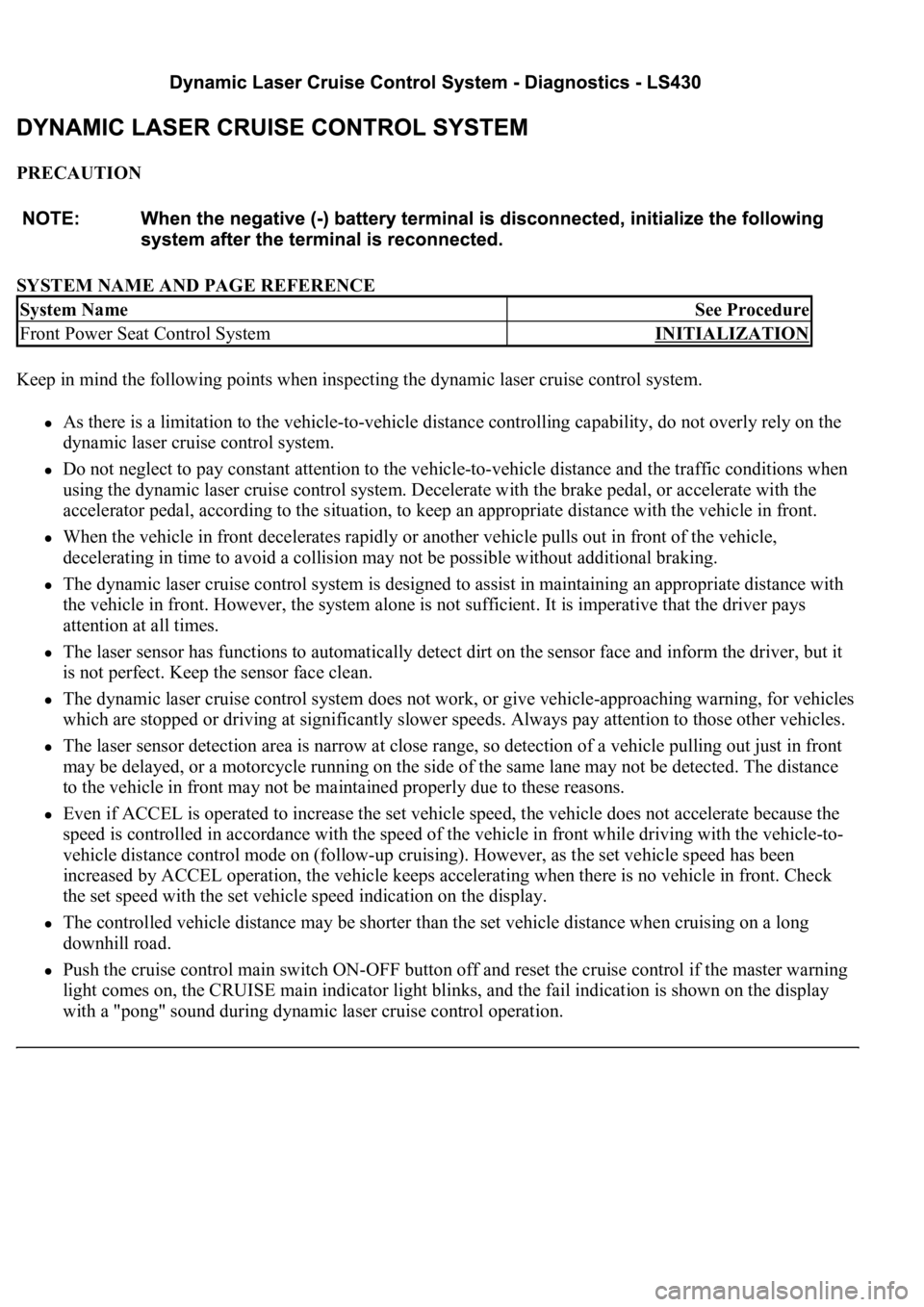
PRECAUTION
SYSTEM NAME AND PAGE REFERENCE
Keep in mind the following points when inspecting the dynamic laser cruise control system.
As there is a limitation to the vehicle-to-vehicle distance controlling capability, do not overly rely on the
dynamic laser cruise control system.
Do not neglect to pay constant attention to the vehicle-to-vehicle distance and the traffic conditions when
using the dynamic laser cruise control system. Decelerate with the brake pedal, or accelerate with the
accelerator pedal, according to the situation, to keep an appropriate distance with the vehicle in front.
When the vehicle in front decelerates rapidly or another vehicle pulls out in front of the vehicle,
decelerating in time to avoid a collision may not be possible without additional braking.
The dynamic laser cruise control system is designed to assist in maintaining an appropriate distance with
the vehicle in front. However, the system alone is not sufficient. It is imperative that the driver pays
attention at all times.
The laser sensor has functions to automatically detect dirt on the sensor face and inform the driver, but it
is not perfect. Keep the sensor face clean.
The dynamic laser cruise control system does not work, or give vehicle-approaching warning, for vehicles
which are stopped or driving at significantly slower speeds. Always pay attention to those other vehicles.
The laser sensor detection area is narrow at close range, so detection of a vehicle pulling out just in front
may be delayed, or a motorcycle running on the side of the same lane may not be detected. The distance
to the vehicle in front may not be maintained properly due to these reasons.
Even if ACCEL is operated to increase the set vehicle speed, the vehicle does not accelerate because the
speed is controlled in accordance with the speed of the vehicle in front while driving with the vehicle-to-
vehicle distance control mode on (follow-up cruising). However, as the set vehicle speed has been
increased by ACCEL operation, the vehicle keeps accelerating when there is no vehicle in front. Check
the set speed with the set vehicle speed indication on the display.
The controlled vehicle distance may be shorter than the set vehicle distance when cruising on a long
downhill road.
Push the cruise control main switch ON-OFF button off and reset the cruise control if the master warning
light comes on, the CRUISE main indicator light blinks, and the fail indication is shown on the display
with a "pong" sound during dynamic laser cruise control operation.
System NameSee Procedure
Front Power Seat Control SystemINITIALIZATION
Page 2433 of 4500

dynamic laser cruise control system.
Operation of the constant speed control mode is the same as that for the conventional type
cruise control system.
b. This system maintains the vehicle running at the speed that the driver has set, as long as there are
no vehicles ahead in the same lane. Then, the system maintains the vehicle distance that has been
set by the driver.
If the system detects a vehicle moving at a slower speed ahead while the driver is driving at a
constant speed, it closes the throttle valve to decelerate. If further deceleration is required, the
system controls the brake actuator in order to apply the brakes. Thereafter, if there are no vehicles
ahead within the set vehicle-to-vehicle distance because either the vehicle ahead or the driver has
changed lanes, the system accelerates slowly to reach the set vehicle speed and resumes driving at
the constant speed.
c. The constant speed control mode is designed to maintain a constant cruising speed. The vehicle-to-
vehicle distance control mode is designed to control cruising at a constant speed function,
deceleration cruising function, follow-up cruising function and acceleration cruising function.
d. The laser sensor and the distance control ECU (cruise control ECU) control the system while the
vehicle-to-vehicle distance control mode is in operation, and send signals to each actuator and
ECU.
e. In vehicle-to-vehicle distance control mode, the dynamic laser cruise control system receives
signals from the yaw rate & deceleration sensor and the steering angle sensor. Based on these
signals, it then estimates curve radius and compensates for information on the preceding vehicle
while turning. It can also compensate for the brake control when approaching another vehicle.
f. This system judges the existence of a vehicle in front and the distance to it based on the signals
from the laser sensor while the vehicle-to-vehicle distance control mode is in operation. Using this
information, the system informs the driver of any danger with the warning buzzer, performs brake
control, and turns on the stop lamp when approaching the vehicle in front.
g. The following illustration shows a control example under the following conditions: own vehicle
speed is 100 km/h (62 mph) and the speed of the vehicle in front is 80 km/h (50 mph).
Page 2437 of 4500
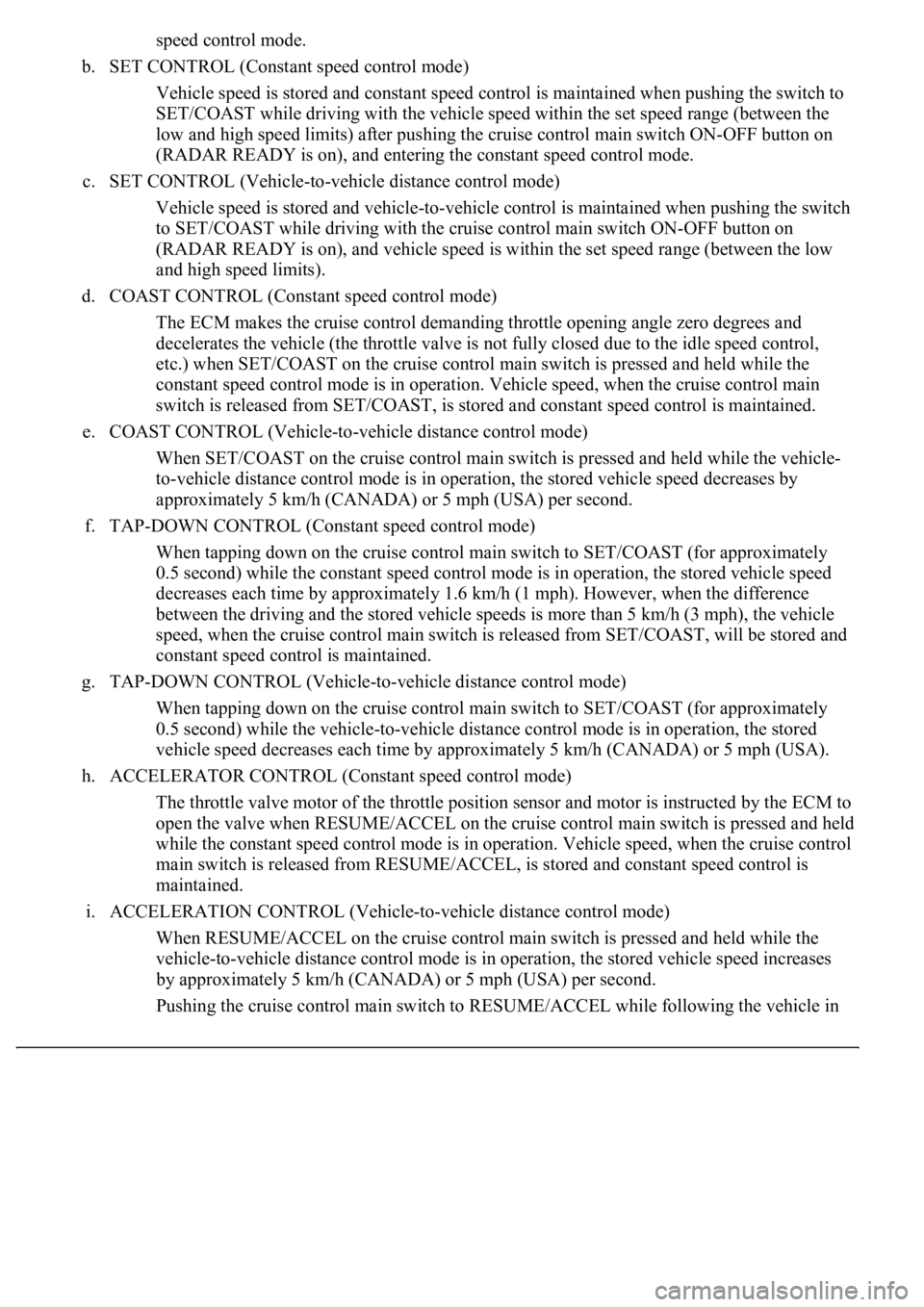
speed control mode.
b. SET CONTROL (Constant speed control mode)
Vehicle speed is stored and constant speed control is maintained when pushing the switch to
SET/COAST while driving with the vehicle speed within the set speed range (between the
low and high speed limits) after pushing the cruise control main switch ON-OFF button on
(RADAR READY is on), and entering the constant speed control mode.
c. SET CONTROL (Vehicle-to-vehicle distance control mode)
Vehicle speed is stored and vehicle-to-vehicle control is maintained when pushing the switch
to SET/COAST while driving with the cruise control main switch ON-OFF button on
(RADAR READY is on), and vehicle speed is within the set speed range (between the low
and high speed limits).
d. COAST CONTROL (Constant speed control mode)
The ECM makes the cruise control demanding throttle opening angle zero degrees and
decelerates the vehicle (the throttle valve is not fully closed due to the idle speed control,
etc.) when SET/COAST on the cruise control main switch is pressed and held while the
constant speed control mode is in operation. Vehicle speed, when the cruise control main
switch is released from SET/COAST, is stored and constant speed control is maintained.
e. COAST CONTROL (Vehicle-to-vehicle distance control mode)
When SET/COAST on the cruise control main switch is pressed and held while the vehicle-
to-vehicle distance control mode is in operation, the stored vehicle speed decreases by
approximately 5 km/h (CANADA) or 5 mph (USA) per second.
f. TAP-DOWN CONTROL (Constant speed control mode)
When tapping down on the cruise control main switch to SET/COAST (for approximately
0.5 second) while the constant speed control mode is in operation, the stored vehicle speed
decreases each time by approximately 1.6 km/h (1 mph). However, when the difference
between the driving and the stored vehicle speeds is more than 5 km/h (3 mph), the vehicle
speed, when the cruise control main switch is released from SET/COAST, will be stored and
constant speed control is maintained.
g. TAP-DOWN CONTROL (Vehicle-to-vehicle distance control mode)
When tapping down on the cruise control main switch to SET/COAST (for approximately
0.5 second) while the vehicle-to-vehicle distance control mode is in operation, the stored
vehicle speed decreases each time by approximately 5 km/h (CANADA) or 5 mph (USA).
h. ACCELERATOR CONTROL (Constant speed control mode)
The throttle valve motor of the throttle position sensor and motor is instructed by the ECM to
open the valve when RESUME/ACCEL on the cruise control main switch is pressed and held
while the constant speed control mode is in operation. Vehicle speed, when the cruise control
main switch is released from RESUME/ACCEL, is stored and constant speed control is
maintained.
i. ACCELERATION CONTROL (Vehicle-to-vehicle distance control mode)
When RESUME/ACCEL on the cruise control main switch is pressed and held while the
vehicle-to-vehicle distance control mode is in operation, the s
tored vehicle speed increases
by approximately 5 km/h (CANADA) or 5 mph (USA) per second.
Pushin
g the cruise control main switch to RESUME/ACCEL while following the vehicle in
Page 2438 of 4500
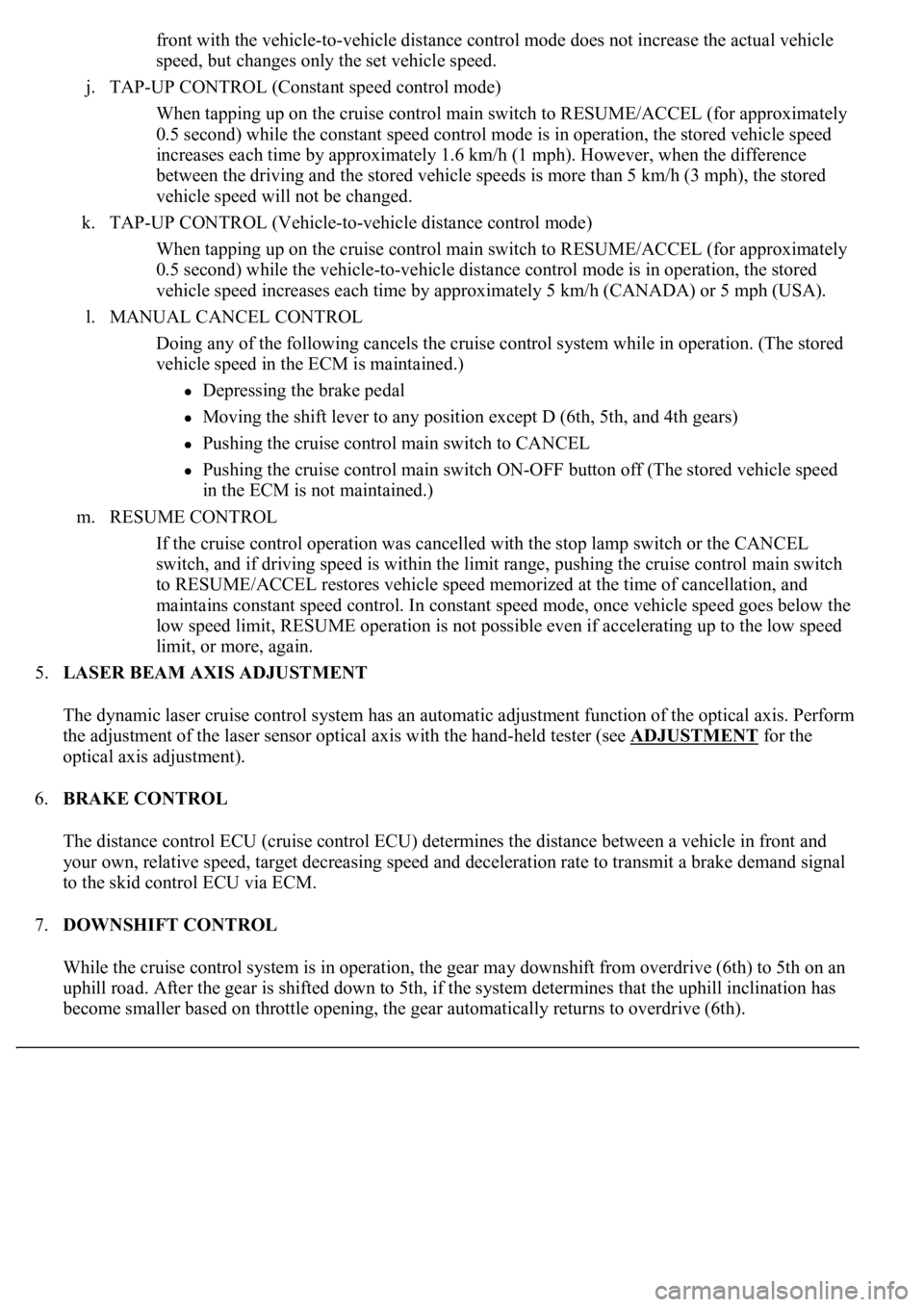
front with the vehicle-to-vehicle distance control mode does not increase the actual vehicle
speed, but changes only the set vehicle speed.
j. TAP-UP CONTROL (Constant speed control mode)
When tapping up on the cruise control main switch to RESUME/ACCEL (for approximately
0.5 second) while the constant speed control mode is in operation, the stored vehicle speed
increases each time by approximately 1.6 km/h (1 mph). However, when the difference
between the driving and the stored vehicle speeds is more than 5 km/h (3 mph), the stored
vehicle speed will not be changed.
k. TAP-UP CONTROL (Vehicle-to-vehicle distance control mode)
When tapping up on the cruise control main switch to RESUME/ACCEL (for approximately
0.5 second) while the vehicle-to-vehicle distance control mode is in operation, the stored
vehicle speed increases each time by approximately 5 km/h (CANADA) or 5 mph (USA).
l. MANUAL CANCEL CONTROL
<00270052004c0051004a000300440051005c00030052004900030057004b0048000300490052004f004f0052005a004c0051004a000300460044005100460048004f005600030057004b00480003004600550058004c005600480003004600520051005700
550052004f00030056005c00560057004800500003005a004b[ile in operation. (The stored
vehicle speed in the ECM is maintained.)
Depressing the brake pedal
<003000520059004c0051004a00030057004b004800030056004b004c004900570003004f0048005900480055000300570052000300440051005c0003005300520056004c0057004c0052005100030048005b0046004800530057000300270003000b001900
57004b000f000300180057004b000f00030044005100470003[4th gears)
Pushing the cruise control main switch to CANCEL
Pushing the cruise control main switch ON-OFF button off (The stored vehicle speed
in the ECM is not maintained.)
m. RESUME CONTROL
If the cruise control operation was cancelled with the stop lamp switch or the CANCEL
switch, and if driving speed is within the limit range, pushing the cruise control main switch
to RESUME/ACCEL restores vehicle speed memorized at the time of cancellation, and
maintains constant speed control. In constant speed mode, once vehicle speed goes below the
low speed limit, RESUME operation is not possible even if accelerating up to the low speed
limit, or more, again.
5.LASER BEAM AXIS ADJUSTMENT
The dynamic laser cruise control system has an automatic adjustment function of the optical axis. Perform
the adjustment of the laser sensor optical axis with the hand-held tester (see ADJUSTMENT
for the
optical axis adjustment).
6.BRAKE CONTROL
The distance control ECU (cruise control ECU) determines the distance between a vehicle in front and
your own, relative speed, target decreasing speed and deceleration rate to transmit a brake demand signal
to the skid control ECU via ECM.
7.DOWNSHIFT CONTROL
While the cruise control system is in operation, the gear may downshift from overdrive (6th) to 5th on an
uphill road. After the gear is shifted down to 5th, if the system determines that the uphill inclination has
become smaller based on throttle opening, the gear automatically returns to overdrive (6th).
Page 2440 of 4500
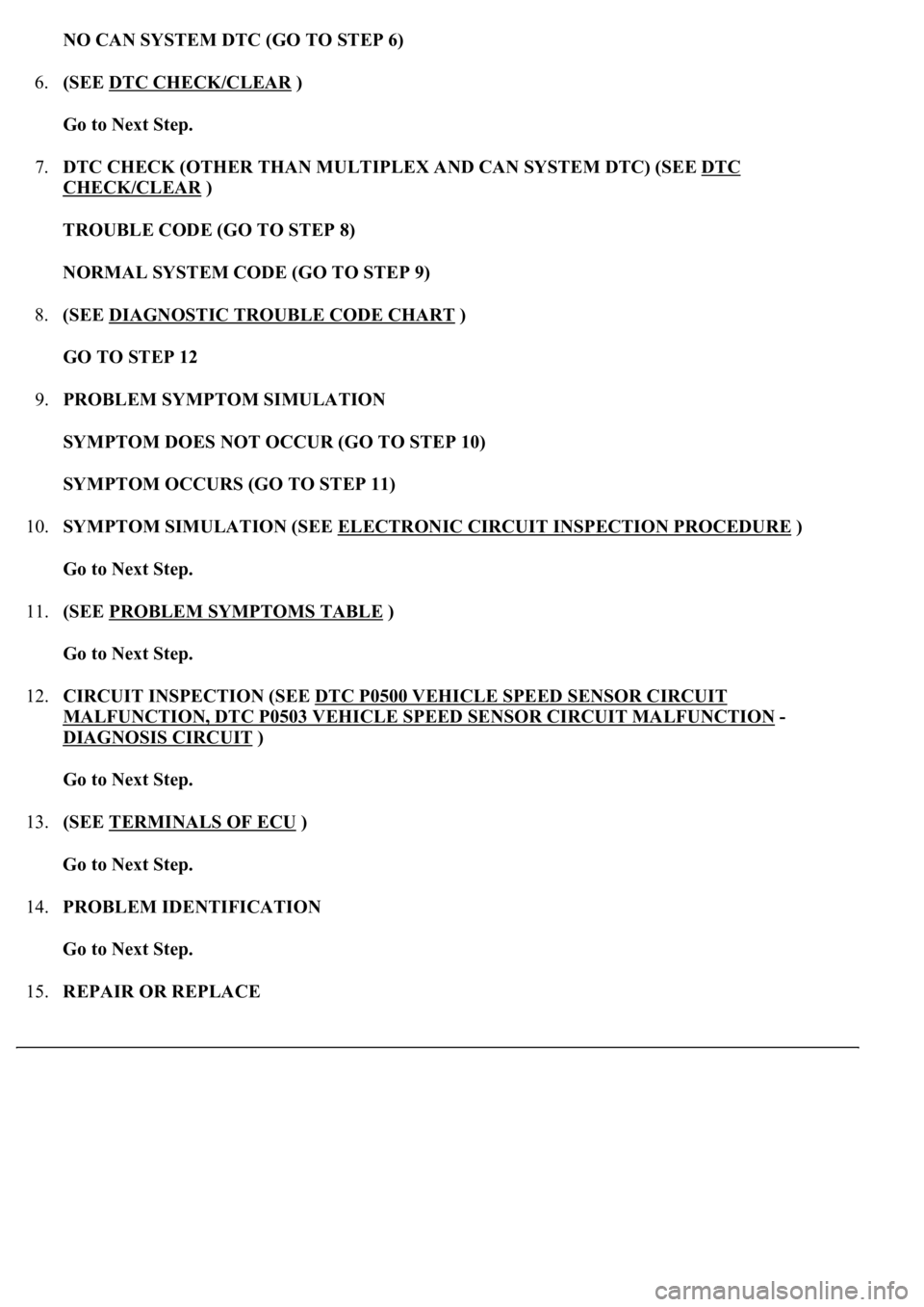
NO CAN SYSTEM DTC (GO TO STEP 6)
6.(SEE DTC CHECK/CLEAR
)
Go to Next Step.
7.DTC CHECK (OTHER THAN MULTIPLEX AND CAN SYSTEM DTC) (SEE DTC
CHECK/CLEAR )
TROUBLE CODE (GO TO STEP 8)
NORMAL SYSTEM CODE (GO TO STEP 9)
8.(SEE DIAGNOSTIC TROUBLE CODE CHART
)
GO TO STEP 12
9.PROBLEM SYMPTOM SIMULATION
SYMPTOM DOES NOT OCCUR (GO TO STEP 10)
SYMPTOM OCCURS (GO TO STEP 11)
10.SYMPTOM SIMULATION (SEE ELECTRONIC CIRCUIT INSPECTION PROCEDURE
)
Go to Next Step.
11.(SEE PROBLEM SYMPTOMS TABLE
)
Go to Next Step.
12.CIRCUIT INSPECTION (SEE DTC P0500 VEHICLE SPEED SENSOR CIRCUIT
MALFUNCTION, DTC P0503 VEHICLE SPEED SENSOR CIRCUIT MALFUNCTION -
DIAGNOSIS CIRCUIT
)
Go to Next Step.
13.(SEE TERMINALS OF ECU
)
Go to Next Step.
14.PROBLEM IDENTIFICATION
Go to Next Step.
15.REPAIR OR REPLACE
Page 2452 of 4500
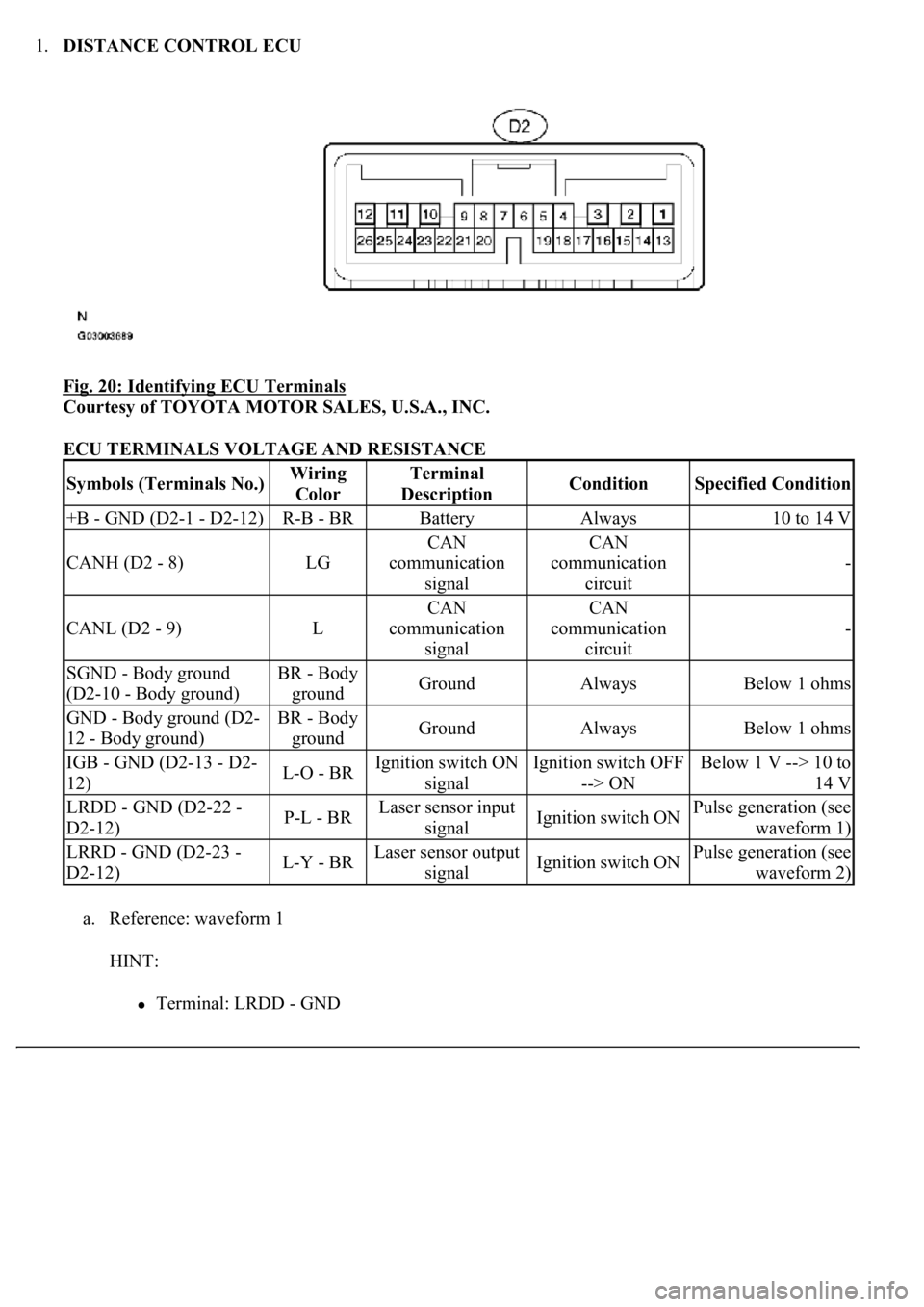
1.DISTANCE CONTROL ECU
Fig. 20: Identifying ECU Terminals
Courtesy of TOYOTA MOTOR SALES, U.S.A., INC.
ECU TERMINALS VOLTAGE AND RESISTANCE
a. Reference: waveform 1
HINT:
Terminal: LRDD - GND
Symbols (Terminals No.)Wiring
ColorTerminal
DescriptionConditionSpecified Condition
+B - GND (D2-1 - D2-12)R-B - BRBatteryAlways10 to 14 V
CANH (D2 - 8)LG
CAN
communication
signalCAN
communication
circuit
-
CANL (D2 - 9)L
CAN
communication
signalCAN
communication
circuit
-
SGND - Body ground
(D2-10 - Body ground)BR - Body
groundGroundAlwaysBelow 1 ohms
GND - Body ground (D2-
12 - Body ground)BR - Body
groundGroundAlwaysBelow 1 ohms
IGB - GND (D2-13 - D2-
12)L-O - BRIgnition switch ON
signalIgnition switch OFF
--> ONBelow 1 V --> 10 to
14 V
LRDD - GND (D2-22 -
D2-12)P-L - BRLaser sensor input
signalIgnition switch ONPulse generation (see
waveform 1)
LRRD - GND (D2-23 -
D2-12)L-Y - BRLaser sensor output
signalIgnition switch ONPulse generation (see
waveform 2)
Page 2455 of 4500
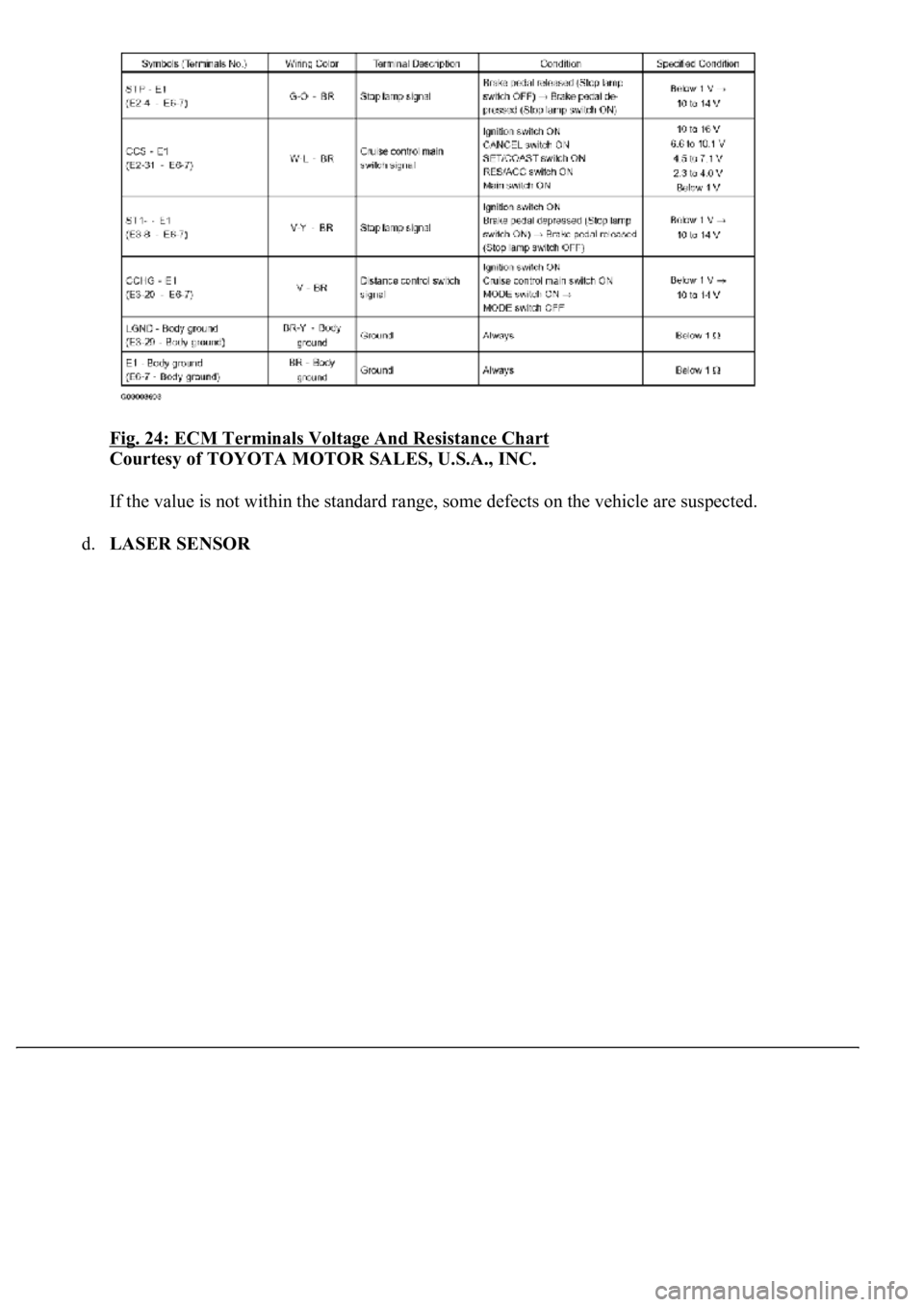
Fig. 24: ECM Terminals Voltage And Resistance Chart
Courtesy of TOYOTA MOTOR SALES, U.S.A., INC.
If the value is not within the standard range, some defects on the vehicle are suspected.
d.LASER SENSOR
Page 2456 of 4500
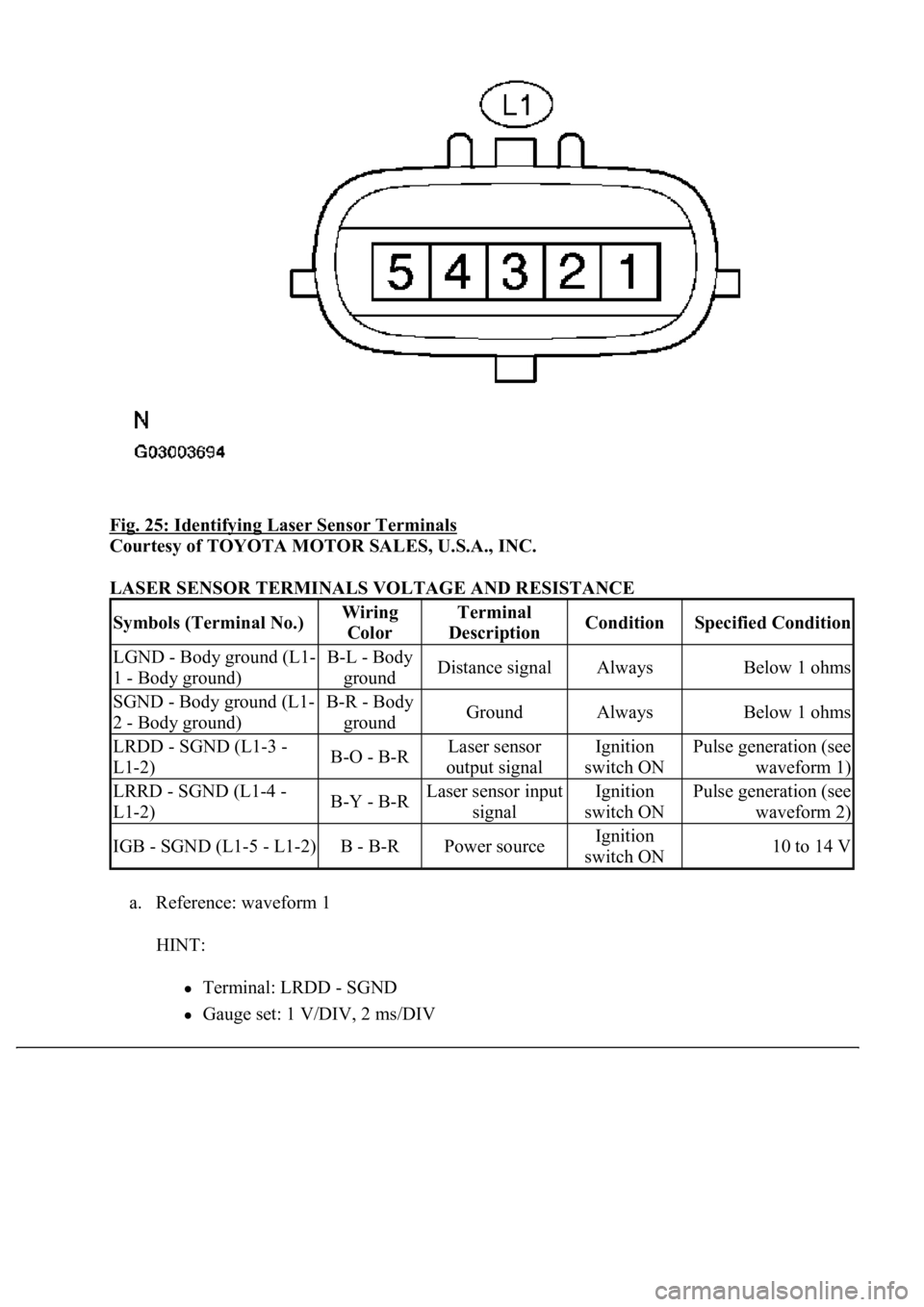
Fig. 25: Identifying Laser Sensor Terminals
Courtesy of TOYOTA MOTOR SALES, U.S.A., INC.
LASER SENSOR TERMINALS VOLTAGE AND RESISTANCE
a. Reference: waveform 1
HINT:
Terminal: LRDD - SGND
Gauge set: 1 V/DIV, 2 ms/DIV
Symbols (Terminal No.)Wiring
ColorTerminal
DescriptionConditionSpecified Condition
LGND - Body ground (L1-
1 - Body ground)B-L - Body
groundDistance signalAlwaysBelow 1 ohms
SGND - Body ground (L1-
2 - Body ground)B-R - Body
groundGroundAlwaysBelow 1 ohms
LRDD - SGND (L1-3 -
L1-2)B-O - B-RLaser sensor
output signalIgnition
switch ONPulse generation (see
waveform 1)
LRRD - SGND (L1-4 -
L1-2)B-Y - B-RLaser sensor input
signalIgnition
switch ONPulse generation (see
waveform 2)
IGB - SGND (L1-5 - L1-2)B - B-RPower sourceIgnition
switch ON10 to 14 V
Page 2463 of 4500
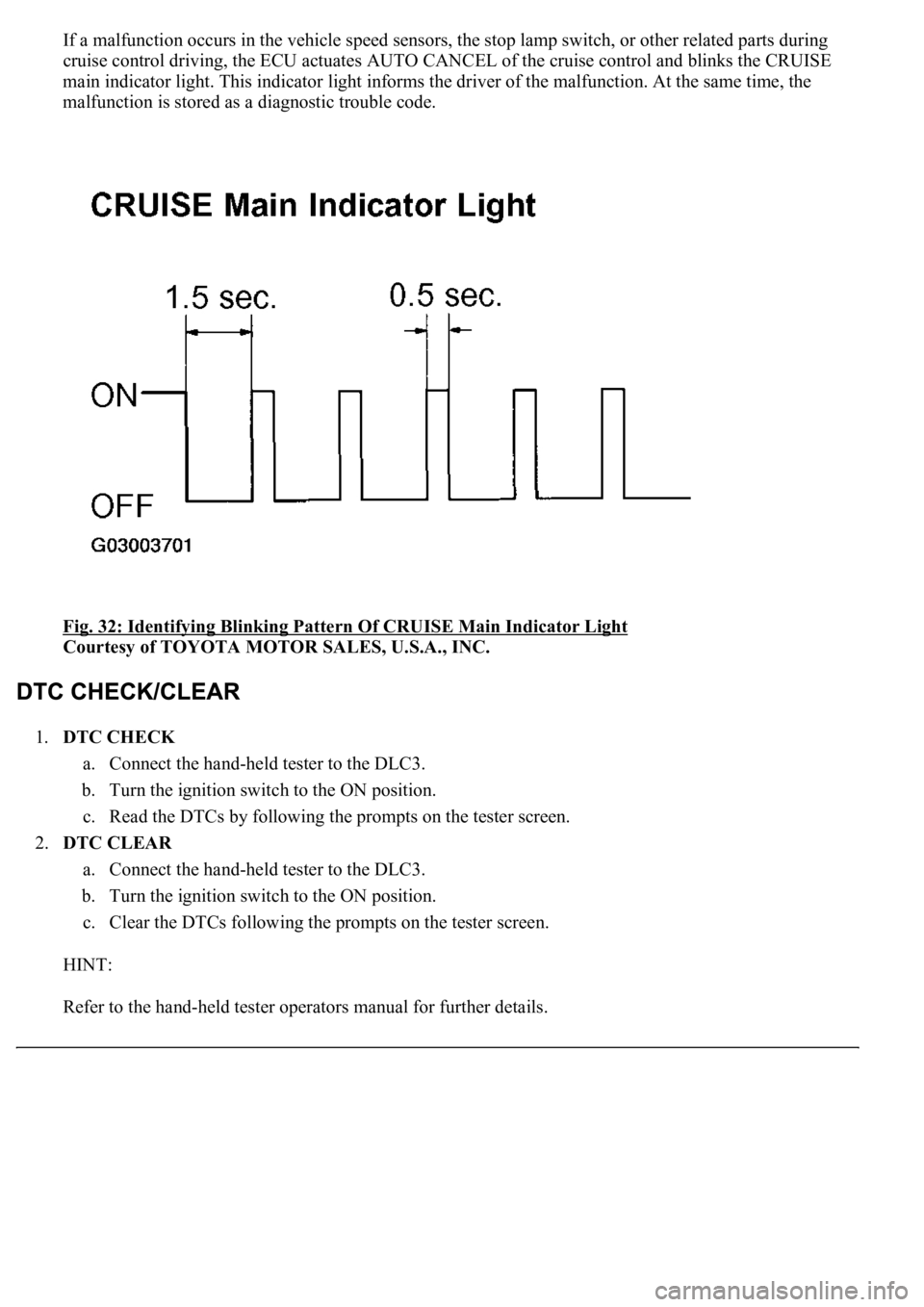
If a malfunction occurs in the vehicle speed sensors, the stop lamp switch, or other related parts during
cruise control driving, the ECU actuates AUTO CANCEL of the cruise control and blinks the CRUISE
main indicator light. This indicator light informs the driver of the malfunction. At the same time, the
malfunction is stored as a diagnostic trouble code.
Fig. 32: Identifying Blinking Pattern Of CRUISE Main Indicator Light
Courtesy of TOYOTA MOTOR SALES, U.S.A., INC.
1.DTC CHECK
a. Connect the hand-held tester to the DLC3.
b. Turn the ignition switch to the ON position.
c. Read the DTCs by following the prompts on the tester screen.
2.DTC CLEAR
a. Connect the hand-held tester to the DLC3.
b. Turn the ignition switch to the ON position.
c. Clear the DTCs following the prompts on the tester screen.
HINT:
Refer to the han
d-held tester operators manual for further details.